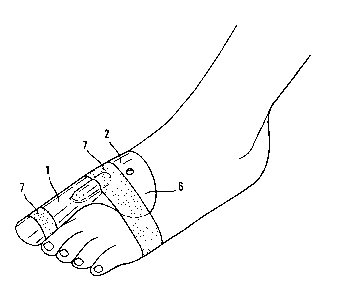Some of the information on this Web page has been provided by external sources. The Government of Canada is not responsible for the accuracy, reliability or currency of the information supplied by external sources. Users wishing to rely upon this information should consult directly with the source of the information. Content provided by external sources is not subject to official languages, privacy and accessibility requirements.
Any discrepancies in the text and image of the Claims and Abstract are due to differing posting times. Text of the Claims and Abstract are posted:
| (12) Patent: | (11) CA 2192127 |
|---|---|
| (54) English Title: | TOE SPLINT FOR AN OUTER TOE |
| (54) French Title: | ATTELLE POUR DOIGT EXTERNE |
| Status: | Expired and beyond the Period of Reversal |
| (51) International Patent Classification (IPC): |
|
|---|---|
| (72) Inventors : |
|
| (73) Owners : |
|
| (71) Applicants : |
|
| (74) Agent: | MARKS & CLERK |
| (74) Associate agent: | |
| (45) Issued: | 2003-04-29 |
| (22) Filed Date: | 1996-12-05 |
| (41) Open to Public Inspection: | 1998-03-19 |
| Examination requested: | 2000-02-07 |
| Availability of licence: | N/A |
| Dedicated to the Public: | N/A |
| (25) Language of filing: | English |
| Patent Cooperation Treaty (PCT): | No |
|---|
| (30) Application Priority Data: | ||||||
|---|---|---|---|---|---|---|
|
The invention relates to a toe splint for an outer toe,
having a rear holding part, which is to be placed against
the metatarsus, and a supporting part, which is
integrally connected thereto and is to be placed upon the
toe to be supported. The holding part and the supporting
part each have a side portion to be placed against the
outer edge of the foot or toe. The improvement according
to the invention consists in the fact that the side
portions are continuously joined in the manner of a
splint.
L'invention se rapporte à une attelle pour doigt de pied, plus précisément un orteil externe, comportant une partie arrière destinée à prendre appui sur le métatarse, et une partie avant devant retenir l'orteil qui doit être supporté. La partie servant à retenir et la partie servant à soutenir sont toutes deux dotées d'un partie latérale qui doit venir en contact avec le bord externe du pied et de l'orteil. L'amélioration apportée par l'invention réside dans le fait que les parties latérales sont en continuité mécanique, comme une attelle.
Note: Claims are shown in the official language in which they were submitted.
Note: Descriptions are shown in the official language in which they were submitted.

2024-08-01:As part of the Next Generation Patents (NGP) transition, the Canadian Patents Database (CPD) now contains a more detailed Event History, which replicates the Event Log of our new back-office solution.
Please note that "Inactive:" events refers to events no longer in use in our new back-office solution.
For a clearer understanding of the status of the application/patent presented on this page, the site Disclaimer , as well as the definitions for Patent , Event History , Maintenance Fee and Payment History should be consulted.
| Description | Date |
|---|---|
| Time Limit for Reversal Expired | 2016-12-05 |
| Letter Sent | 2015-12-07 |
| Inactive: IPC from MCD | 2006-03-12 |
| Grant by Issuance | 2003-04-29 |
| Inactive: Cover page published | 2003-04-28 |
| Inactive: Final fee received | 2003-02-06 |
| Pre-grant | 2003-02-06 |
| Notice of Allowance is Issued | 2002-09-24 |
| Notice of Allowance is Issued | 2002-09-24 |
| Letter Sent | 2002-09-24 |
| Inactive: Approved for allowance (AFA) | 2002-09-10 |
| Amendment Received - Voluntary Amendment | 2001-05-29 |
| Amendment Received - Voluntary Amendment | 2000-06-27 |
| Letter Sent | 2000-03-28 |
| Inactive: Status info is complete as of Log entry date | 2000-03-27 |
| Inactive: Application prosecuted on TS as of Log entry date | 2000-03-27 |
| All Requirements for Examination Determined Compliant | 2000-02-07 |
| Request for Examination Requirements Determined Compliant | 2000-02-07 |
| Inactive: Cover page published | 1999-09-30 |
| Application Published (Open to Public Inspection) | 1998-03-19 |
There is no abandonment history.
The last payment was received on 2002-11-27
Note : If the full payment has not been received on or before the date indicated, a further fee may be required which may be one of the following
Please refer to the CIPO Patent Fees web page to see all current fee amounts.
Note: Records showing the ownership history in alphabetical order.
| Current Owners on Record |
|---|
| WALDEMAR LINK (GMBH & CO) |
| Past Owners on Record |
|---|
| ROBERT D. LOCKHART |